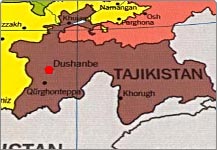Istaravshan
Dushanbe | Khojand | Khorog | Penjikent | Murgab | Kulyab
Istravshan is an ancient center of trade and craft as well as one of the ancient cities in Central Asia. It is really a museum city with its history dating back to II-VI cc BC. In Persian literature the city was known as Kurukuda, In Sogdian ancient notes as Kurushkuda while modern scholars identify it with Cyruspol or Cyrus Eskhata founded in VI century BC by Cyrus the Great. At that time ancient Isaravshan was fortified with 3 walls and had citadel surrounded by walls total length of which exceeded  6km. The city was famed for trade, skilful masters and profitable trade deals.From II-VI cc BC to I-II cc AD Istaravshan was known as Bunjikat- a capital of Ustrushuna and peopled with local aristocracy lived in numerous palaces with original and expressive architecture. The evidence to this are recently discovered ancient settlements of Bundjikat (Kala-I-Kahkah) and Chilhudjra which were well fortified and along with numerous palaces had many places of public worship decorated with paintings and carved panels.
In Bundjikat was found a part of painting with she-wolf feeding 2 infants which witness the city had developed connections with western countries.
During the Arab rule, Istaravshan became province of Arab caliphate in 822 and was well known in the Muslim middle century East as trade and cultural center. Also at this time in Istaravshan were introduced Islam architecture principles based on development of portal and dome constructions: mosques, mausoleums, minarets etc.
Istaravshan glooming period was under the rule of first ethnic Tajik dynasty of Samanids (IX-X cc) while in XIII it was ruined by Chinghiz Khan and his Mongol army.
It took almost a century for Istaravshan to recover from Mongol invasion and in XIV c under Tamerlane rule the city was renamed Ura Tube. In XVI c with development of new state of Sheibanids with capital in Bukhara, Ura Tuppe as well as Maveranahr state lost its importance and transit trade from India appeared to be a monopoly of other states.
In XVIII Ura Tuppe was completely rebuilt, old buildings restored and built many new ones. Citadel and city walls were fortified and could now defend attacks of numerous nomadic turk-mongol tribes.  The city's territory of that time was 527 hectares and had citadel, mosques, madrassahs, six bathhouses and many chaikhonas.
Before Istaravshan was annexed by Russian empire In 1886 it knew 17 rulers some of ruled of no longer than a week and 50 attacks with loots and kidnapping.
By the end of XIX c in Istaravshan were 68 mosques, 16 karavan serais, 5 oil mills, 7 mills, 7 bathhouses and many bazaars.
Things to see here include Kok Gumbaz and Khazrat-i-Shokh Mausoleum apparently dated to 18th century.
Kok Gumbaz also known as Abdulatif Sultan mosque is a XVI c monument built by Abdulatif - a son famous astronomer and philosopher Ulugbek.†A legend says Abdulatif quarreled with his famous father and left home. He found some work with an old peasant digging water channels to moisture his filed and suppose to get paid 100 tenge for his work. His father looking for him found his employer and took 100 tenge of his son's money added some of his own and built a madrassah which by the end of XIX c had 22 students and 8 teachers.
The main building is built of square bricks and has large square area inside with 4 deep niches. One of the niches has Mirhab - a window orientated to Mekka, decorated with rich stucco alabaster arch. The walls are decorated with paintings while Entrance portal and dome have majolica revetment.
Double domed building of Khazrat-i-Shokh built in XVIII over the grave of Abbas - a cousin of prophet Muhhamad ibn Kusama.
Tajikistan | Hotels | Tours | Airport Transfer | Visa&Formalities | Go See





 Little Pamir 22 day
Little Pamir 22 day




